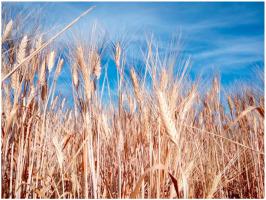Weather and Climate Extremes ( IF 8 ) Pub Date : 2020-09-10 , DOI: 10.1016/j.wace.2020.100281 Barbara Templ , Pierluigi Calanca

|
Exposure to a critical high temperature during the reproductive period can harm wheat development, entail yield losses and lead to yield instability. In the recent past, Russian wheat production suffered a few times from marked downturns caused by heat waves that eventually had repercussions on the global wheat market. In this study, we assess the frequency of heat stress days on Russian spring and winter wheat production using climate scenarios generated from five general circulation models and reflecting four emission scenarios. We find that the fraction of cultivated area characterized by a significant positive trend in risk increases sharply if global warming exceeds 1.5 °C targeted by the Paris Agreement. Currently particularly affected areas are the main cultivation regions in the southern Urals and southern Siberia (spring wheat) and southern European Russia (winter wheat). In scenarios not foreseeing mitigation, conditions comparable to those experienced in 2010, considered here as a critical year, could become rather common in the future. We estimated that the probability of incurring in a critical year within a 30-year time window could reach 40–60% (spring wheat), respectively 20-40% (winter wheat) during the second half of the century, over most of the Russian territory. Our analysis suggests that expansion of the cultivation area towards more northern latitudes is not sufficient to prevent risk associated with heat waves, suggesting the need for other measures of adaptation to sustain production and stabilize yield.
中文翻译:

超过1.5 C的全球变暖,俄罗斯小麦生殖生长期间热应激发生的临界增加
在生育期暴露于临界高温会损害小麦发育,造成单产下降并导致单产不稳定。在最近的过去,俄罗斯小麦的生产遭受了几次热浪的严重影响,这些热浪最终对全球小麦市场产生了影响。在这项研究中,我们使用从五个总体循环模型生成并反映四个排放情景的气候情景,评估了俄罗斯春小麦和冬小麦生产中热应激日的频率。我们发现,如果全球变暖超过《巴黎协定》规定的1.5°C,则以风险显着正趋势为特征的耕地面积将急剧增加。目前受灾最严重的地区是乌拉尔南部和西伯利亚南部(春小麦)和欧洲南部俄罗斯(冬小麦)的主要种植区。在无法预见缓解的情况下,与2010年相比(在这里被认为是关键的一年)所经历的情况将来可能会变得相当普遍。我们估计,在本世纪的下半叶,在30年的时间范围内,关键年份的发生概率可能分别达到40-60%(春小麦)和20-40%(冬小麦)。俄罗斯领土。我们的分析表明,将种植区域扩大到更多的北纬不足以防止与热浪有关的风险,这表明需要采取其他适应措施来维持产量和稳定产量。


























 京公网安备 11010802027423号
京公网安备 11010802027423号